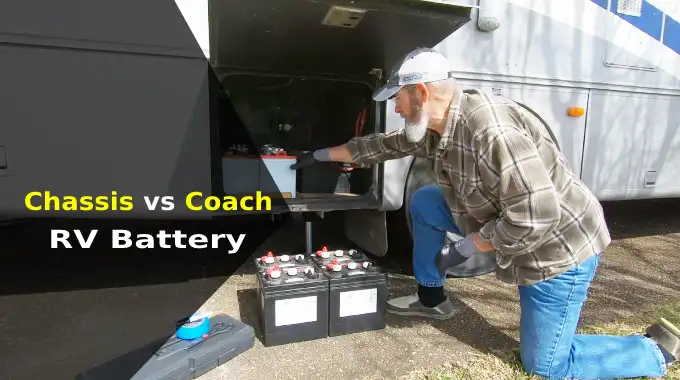Last Updated on May 3, 2023
Are you planning a memorable road trip with your RV soon? If so, there are a few things you need to know about your RV’s battery system. One aspect you should consider is the difference between chassis and coach RV batteries.
Even though both battery systems power your RV’s appliances and systems, they have varying CCA ratings to do different things. The chassis battery is designed to power the vehicle’s engine and essential components, while the coach battery powers all the appliances and accessories inside the RV.
Hence, choosing the right battery system is vital to ensure a comfortable and safe trip. Today we’ll dive into the nitty-gritty of the Chassis vs. Coach RV Battery Comparison by exploring their differences and purposes. Find out the differences and how to choose the right one.
Chassis vs Coach RV Battery: Comparison
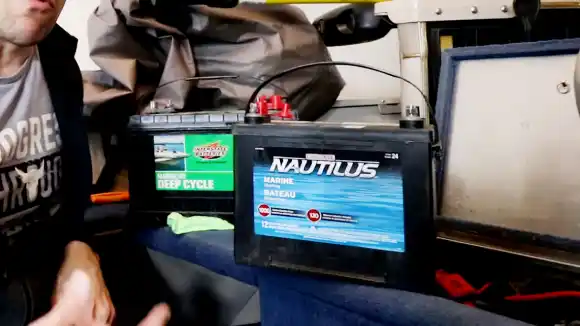
Regarding RV batteries, there are two main types: Chassis and Coach batteries. Chassis batteries are designed to power the engine and other automotive systems, while coach batteries provide electricity for the living quarters of the RV. Here are some differences between these:
Differences in Cold Cranking AMP (CCA)
Chassis batteries power the engine and other RV components requiring high-cranking power. These batteries usually have a higher cold cranking amp (CCA) rating than coach batteries, which means they can deliver more power in a short burst.
Conversely, coach batteries provide power to all the appliances and systems inside the RV when it’s not connected to shore power. They have a lower CCA rating than chassis batteries because they don’t need as much cranking power.
Differences in Purpose
Chassis batteries power the vehicle’s engine and other essential components such as headlights, taillights, and turn signals. They are essentially the same type of battery used in cars and trucks.
Meanwhile, coach batteries power the living accommodations of an RV. This includes refrigerators, air conditioners, televisions, and lighting systems. Essentially, coach batteries provide all the comforts of home while on the road.
Battery Functionality
Chassis batteries are lead-acid batteries known for their durability and low cost. They come in various sizes and capacities, depending on the size and weight of the RV. The most common chassis batteries used in RVs are Group 24, Group 27, and Group 31. Chassis batteries only power the engine and its electrical components.
Coach batteries, also known as a house or auxiliary batteries, are designed to power the living quarters of an RV. The functionality of coach batteries is different from that of chassis batteries. Coach batteries focus on providing power to the non-driving components of an RV.
Differences in Power Output
The power output of a chassis battery is measured in cold cranking amps (CCA), which refers to the amount of current that can be delivered at 0°F for 30 seconds without dropping below a specified voltage threshold.
A typical chassis battery might have a CCA rating of 600-800 amps, although some high-performance models can deliver up to 1000 amps or more.
Coach batteries are designed to provide power to the living quarters of an RV, including appliances, lights, and other electronic devices. These batteries are typically deep-cycle, meaning they can discharge up to 80% of their capacity before recharging.
Installation Location
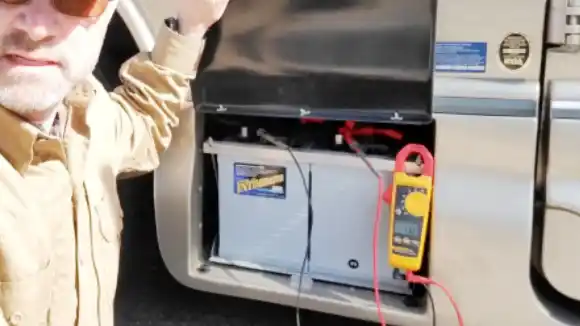
Chassis batteries are typically located under the hood of an RV, near the engine. This placement allows for easy access and maintenance by mechanics. But, it can also make it more difficult for RV owners to perform DIY maintenance.
The location of the chassis battery also affects its temperature regulation. Since it is located in the engine compartment, it is subject to high temperatures that can shorten its lifespan. To combat this, some chassis batteries come equipped with a battery box or insulation to protect them from extreme heat.
Coach batteries are typically located in a separate compartment from the chassis battery. This compartment can be found in various locations depending on the RV’s design. Some models have them installed underneath the driver’s seat or outside the vehicle’s side compartment.
Charging Methods
One of the most common ways to charge a chassis battery is through the alternator while driving. As the engine runs, it turns a belt that drives the alternator, which generates electricity to charge the battery. This method is efficient and reliable since it charges the battery while powering other automotive systems.
Another way to charge your chassis battery is through a dedicated charger or converter. These devices convert AC power from an external source (such as a campground hookup or generator) into DC power that can charge the battery.
The most common method for charging Coach batteries is shore power. The RV’s converter charges the coach battery when connected to a campground or other power source. This method is convenient and reliable but may not be available in all locations.
Another option is a generator. Many RVs come equipped with a generator that can charge the coach battery while also providing power to other systems in the RV. This method is useful when camping off-grid or when shore power is unavailable.
Solar panels are becoming increasingly popular as a way to charge coach batteries. They harness energy from the sun and convert it into electricity that can be used to charge the battery. This method is environmentally friendly and can be used anywhere there is sunlight.
Maintenance Requirements
Chassis batteries require less maintenance than coach batteries because they are designed to start the engine and power the vehicle’s electrical components while driving. These batteries are typically sealed and do not require regular water checks or top-ups.
Conversely, coach batteries are responsible for powering all of the appliances and electronics in the living area of the RV when not plugged into shore power. These batteries are often deep-cycle, so they can be discharged more deeply before recharging.
Similarities Between Chassis and Coach RV Batteries
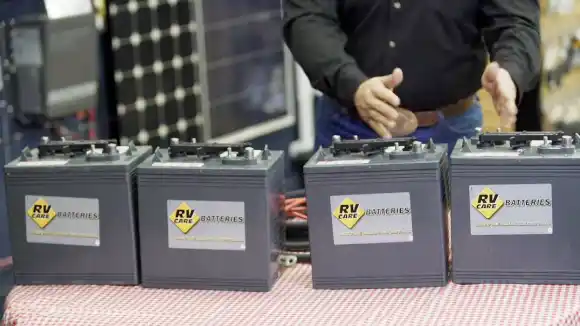
Chassis and coach RV batteries have their differences and similarities. One of the most significant similarities is that both types of batteries are essential for powering an RV’s electrical system.
Both chassis and coach RV batteries can power different parts of an RV. The chassis battery starts the engine, while the coach battery powers everything inside the RV, such as lights, appliances, and electronics.
Another similarity between chassis and coach RV batteries is that they require regular maintenance for optimal performance. It’s important to check the water levels in both types of batteries regularly and keep them charged properly.
Pros and Cons of Chassis and Coach RV Batteries
Even though these two types of batteries power your RV, they both have some pros and cons:
Pros and Cons of Chassis RV Battery
One advantage of a chassis RV battery is that it can provide power to start the engine even if the coach battery is dead or disconnected. However, since it primarily powers mechanical components, it may not be sufficient for powering appliances or electronics inside the RV.
To maintain a chassis RV battery, it’s essential to regularly check water levels in flooded lead-acid batteries and keep them clean and free from corrosion. AGM batteries do not require maintenance but should still be kept clean.
Pros and Cons of Coach RV Batteries
One of the main advantages of coach RV batteries is their capacity for deep cycling. This means they can be discharged to a much greater extent than chassis RV batteries without causing damage to the battery.
Coach RV batteries also tend to have a longer lifespan than chassis RV batteries because they are designed for continuous use.
But there are some downsides to coaching RV batteries as well. They can be more expensive than chassis RV batteries due to their higher capacity and specialized design. Also, they may require more maintenance and monitoring than chassis RV batteries because of their deeper cycling capabilities.
How long does an RV coach battery last?
An RV coach battery typically lasts between 3 and 4 years. But the lifespan of a battery is subject to various factors that may significantly decrease its longevity. These factors include the frequency of use, climate, and maintenance.
For instance, extreme temperatures, such as hot summers or freezing winters, can shorten the battery’s life. Similarly, a lack of proper maintenance, like not checking the water levels or not using battery trickle chargers, can reduce its usable life.
How Long do RV Chassis Batteries Last?
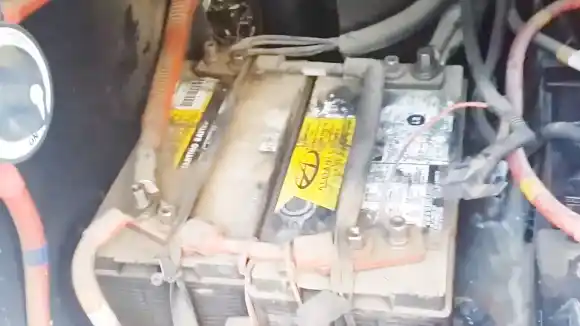
An RV chassis battery should last for 6 or more years. However, like the RV coach battery, the life of an RV chassis battery also depends on several factors. The most common culprit that leads to the rapid death of an RV chassis battery is leaving it unused or underutilizing it for an extended period.
This is because batteries left unused for extended periods gradually lose their charge, leading to premature failure. To extend your RV chassis battery’s life, use it regularly, keep it charged, and maintain it properly.
Why does my RV chassis battery keep dying?
The two most common reasons for an RV chassis battery’s premature death are undercharging and overcharging.
Undercharging occurs when the battery does not receive a full charge, leading to its gradual deterioration. At the same time, overcharging occurs when the battery receives too much charge, causing it to heat up and eventually fail.
Also, undercharging can result from a failing charging system or leaving the battery discharged for an extended period, while overcharging can result from using an incorrect charger or charger malfunction.
How do I keep my RV chassis battery charged?
The easiest way to keep your RV chassis battery charged is to start the engine and let the alternator do its job. But this solution is only practical when you’re on the road.
When parked for an extended period, the best way to keep the chassis battery charged is by using a maintenance charger, also known as a trickle charger. This charger provides a low current to the battery, preventing it from discharging and keeping it charged indefinitely.
Another option is solar panels, which convert sunlight into power to keep your battery charged. Both methods are efficient and practical and help prevent premature battery failure due to undercharging.
Find the Perfect RV Battery: Evaluate Power & Durability
When choosing between a chassis RV battery and a coach RV battery, there are several critical factors to consider. The chassis RV battery is typically smaller and less expensive, but it may not provide as much power or last as long as the coach RV battery.
Conversely, the coach RV battery is larger and more expensive but can handle heavier loads and last longer. Both types of batteries require regular maintenance to ensure optimal performance and longevity.
In the end, you have to decide what type of battery you want based on your preferences and needs. Regardless of your battery type, it’s worth remembering that proper maintenance is crucial for RV electrical system functioning.
